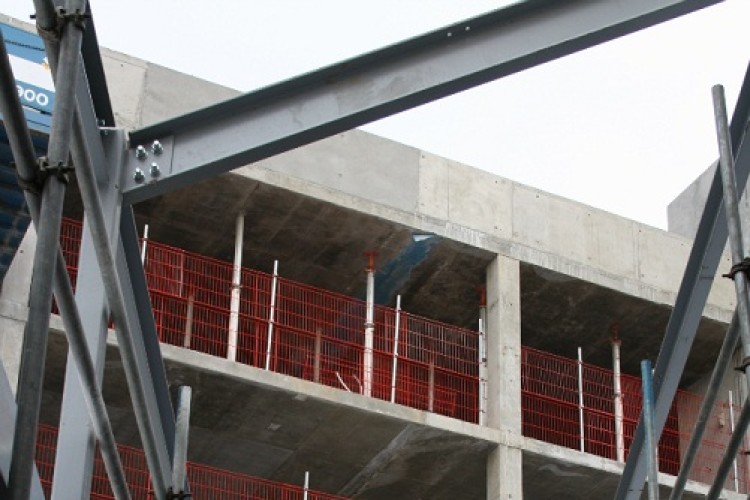This is installed at minimum cost and inconvenience to the installing trade, as they gain no benefit from it. Invariably the edge protection then hinders the first protected trade and gets moved. There is often a delay period between slab completion and cladding arriving, and responsibility for the edge protected area changes. At this point the equipment being used is reviewed and frequently changed or adjusted. Finally the cladding activity arrives and the edge protection is in the way again, frustrating access to the building edge. This regularly results in another change or move. All this costs money, and it is primarily due to a lack of detailed planning, limited flexibility within the edge protection provided, and invariably poor communication between the trades.
For Ormiston Academy, a six-storey specialist BSF Academy for media studies being built in steel within a regeneration area in Birmingham, Bovis Lend Lease decided to challenge this general situation. By connecting Elland Steel Structures, the steel fabricator, and Combisafe, Europe’s leading edge protection supplier, at an early stage in the project design, a significantly flexible edge protection system was selected, that satisfied the needs of all the protected trades at every stage of the project. This early decision also allowed the steel design to accommodate the fixing needs of the edge protection selected.
The project demanded an edge protection system to meet the European Standard, EN 13374 Class A. It needed to be up to 2m high to contain windblown debris and materials, and required a mesh panel and toe board. It also needed to allow access to the building edge for installation of the cladding system fixing cleats, preferably whilst protecting the cladding installers.
The site team decided to use a 2m high system based upon the Combisafe SMB (Steel Mesh Barrier). This satisfied both the compliance and the containment issues. The system could be pre-installed into sockets or bolt holes pre-positioned by Elland within the perimeter steel work, thus minimising work at height during installation. By additionally specifying the Combisafe SMB Beam Holders to be used in all locations, the whole edge protection system attracted substantial additional flexibility.

These SMB Beam Holders allow a double guard rail beam to be positioned outside the line of the SMB and to be supported on the same posts. The SMB Beams are put in place over the existing system, whilst at all times the installer is protected from falling by the previously installed SMB. The beams can be used in isolated locations, on various levels, or along whole elevations. Once the SBM Beam is in place, the SMB panel can be removed from the inside, allowing protected free access to the edge of the building, and allowing the cladding contractor to reach through the SMB Beam to position and fix the cladding cleats.
In this way the edge protection was initially installed to the perimeter steel work at ground level, and subsequently could be adjusted in position and worked through, in any location on the project. At all times the installers and other trades were collectively prevented from falling, and at no time needed to use a harness and lanyard.
The project was a total success, with high productivity in both the frame erection and the cladding installation. The foresight shown by Bovis Lend Lease, in connecting Elland Steel Structures and Combisafe’s engineering service at so early a stage in the project, ensured that in this unique situation the Client only paid once.
Got a story? Email news@theconstructionindex.co.uk



